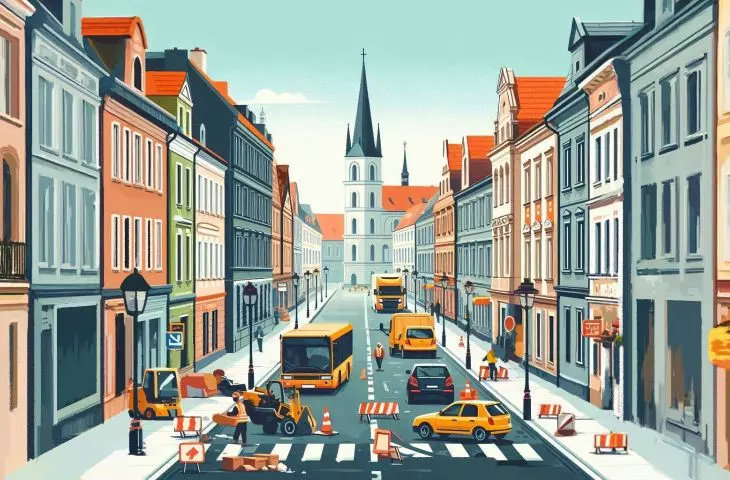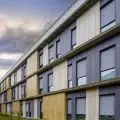Traffic calming is a key element in improving road safety, reducing noise and air pollution, and restoring urban space to its residents.
Traffic calming is a widely used strategy in Europe to improve road safety, reduce vehicle speeds and create friendlier urban environments.
Traffic calming originated in Europe, with one of the earliest examples being the Dutch woonerf projects of the 1970s. The concept quickly spread to other countries, especially Germany and the Netherlands. Traffic calming was developed in Europe as a set of design and management strategies to balance vehicular traffic on streets with their other functions. The idea is based on the belief that streets should serve not only for the passage of cars, but also for walking, meeting, playing, shopping and working, while creating and maintaining a sense of place.
some recipes
There are a number of effective methods that can be used in cities and smaller towns to achieve the goal of creating a safe street. These techniques aim to reduce the impact of automobile traffic by slowing it down, which contributes to creating pedestrian-friendly spaces. Traffic calming tools differ from the traditional street design approach, which treats the space solely as a place for cars, preferably moving at maximum speed.
Thecost of the project varies depending on the location and scope of the measures, but the basic idea is to finance it as little as possible. The original Dutch woonerf required the reconstruction of the street and the removal of curbs and sidewalks to create a shared space, and was therefore quite expensive. However, strategies can include very low-cost solutions such as painting lines, using flower pots, posts or other portable barriers, as well as eliminating or adding parking spaces and installing sidewalk extensions with temporary materials. These techniques allow different solutions, combinations and locations to be tested and then adjusted based on the results. This approach makes it possible to quickly improve the quality of life in a given location, while allowing solutions to be tested and refined over the long term. If the change is successful, further funding can be sought, turning temporary elements into permanent ones, rebuilding streets and implementing permanent infrastructure.
sign is not everything
Groups of traffic calming measures include legal and construction (physical) solutions. The first category includes those solutions that are defined only by regulation. One of the basic methods here is the creation of speed limit zones, where speeds are limited to 30 km/h. They are one of the most common ways to reduce vehicle speeds. In theory, such speed limits are supposed to significantly reduce the risk of accidents, while at the same time also contributing to the comfort of residents by reducing noise and emissions.
Simply putting up a sign with a speed limit does not change much. First, we drive by habit, with a speed limit of 50 km/h, and second, environmental psychology is at work - when the street is wide, we drive faster. Therefore, in developing traffic calming strategies, it is important to keep in mind the implementation of physical traffic calming measures.
Physical traffic calming measures, such as speed bumps, elevated pedestrian crossings and pedestrian refuges (enclaves), are very effective in reducing vehicle speeds. Slowing thresholds force drivers to slow down significantly, while elevated crosswalks and refuges improve pedestrian safety by increasing crossing visibility.
meanders and chicanes
Optical narrowing of lanes is an effective method of traffic calming that affects the driver's psyche and behavior on the road. The technique involves making visual changes to the roadway that make drivers perceive it as narrower and more challenging, which in turn affects their driving behavior. The method gives drivers the impression that the roadway is narrower or more winding, which naturally increases their alertness. This sense of potential danger prompts them to be more cautious when driving. This makes drivers more aware of their surroundings and more attentive, leading to safer driving on the road.
Chicanes, one way to escalate a roadway, encourage drivers to reduce their speed and can be created using either signs, vegetation or alternate parking. Chicanes are a series of alternating curb extensions or islands in the middle of the roadway that narrow it and require vehicles to travel in a winding path, which discourages speeding.
Another tool are sidewalk widenings at selected locations - most often at pedestrian crossings, which shorten their distance. These sidewalks can also serve as places for various functions - kiosks, bike racks or lighting.
Mention should also be made of an asylum island, which is a safe place (island) for pedestrians placed in the middle of the roadway. Its purpose is to ensure safe crossing of the street. It allows them to divide this process into stages and minimizes the need to watch traffic from one direction. In addition to facilitating pedestrians, the asylum island helps reduce vehicle speeds and makes it more difficult to overtake. These islands are made of various materials, such as concrete, rubber or plastic, in accordance with local regulations, which specify minimum dimensions, recommending a width of no less than 2.5 meters for comfortable use, especially for larger groups of pedestrians or people driving bicycles. Such an island should also be as shaded as possible to avoid exposing pedestrians to standing in the sun on a heated surface.
differently parked, differently traversed
Another example is the change of parking from parallel to diagonal. This solution not only increases the number of parking spaces, but also forces drivers to be more careful. Converting one-way streets to two-way narrows the roadway, so we naturally slow down. Narrowing streets can also be done in favor of widening the sidewalk, which makes it easier for pedestrians to get around and improves safety, and can also create space for public transportation or bike lanes.
Replacing priority intersections with equivalent intersections or traffic circles also promotes smoother and safer traffic. Even mini-roundabouts, or islands in the middle of intersections, help calm traffic, reduce collision points and often eliminate the need for traffic lights. To the package of solutions here should also be added the tightening of driving curves, or the deliberate raising of roadway corners on curves. These not only reduce the space for vehicles, as they simultaneously reduce speed and increase safety.
An important element is the implementation of an appropriate parking policy and the prioritization of the road-street network. Reducing the number of parking spaces in the city center and managing road accessibility reduces car traffic, while promoting alternative modes of transportation, such as bicycles and public transportation.
Changing the organization of traffic can also be done by designating one-way streets with bicycle contraflows or closing some streets to car traffic. For many people, this radical solution can significantly improve the safety and comfort of getting around the city, especially if you are a pedestrian, bicyclist, or move around in a wheelchair or scooter.
Most often, the effect is to create closed enclaves that eliminate vehicular traffic through designated areas. Such solutions make streets more pedestrian- and bicycle-friendly, which improves the quality of life for residents, but care must be taken to prevent such a place from becoming a space of gentrification.
The best results come from comprehensively transforming streets into pedestrian-friendly spaces, combining various traffic calming methods. This type of approach allows the creation of multifunctional public spaces that foster social integration and active lifestyles.
The goal of all of the above methods is not only to improve traffic safety, but also to reduce exhaust and noise emissions, as well as to restore the streets to their character as meeting and recreational places. The choice of specific solutions should always take into account the specifics of the area and the needs of the local community.
When planning the implementation of traffic calming tools, a number of factors should be taken into account, such as the presence of emergency vehicles, the nature of the surrounding development, and the needs of various users, including children, the elderly and people with disabilities. It is also important to consider existing improvement plans for the area, as well as the type of streets and desired traffic speed. Analysis of these aspects allows the traffic calming strategy to be optimally adapted to specific conditions and needs. Traffic calming is a key element of modern urban policy that brings tangible benefits to both residents and the environment.














